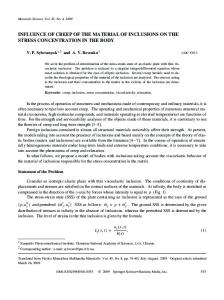On the Measurement of Material Creep Parameters by Nanoindentation
- PDF / 331,673 Bytes
- 6 Pages / 612 x 792 pts (letter) Page_size
- 30 Downloads / 425 Views
R4.7.1
On the Measurement of Material Creep Parameters by Nanoindentation J.A. LaManna1, W.C. Oliver2, and G.M. Pharr1,3 1 The University of Tennessee, Dept. of Materials Science and Engineering, Knoxville, TN 2 MTS Systems Corp., Nano Instruments Innovation Center, Oak Ridge, TN 3 Oak Ridge National Laboratory, Metals and Ceramics Division, Oak Ridge, TN ABSTRACT Previous studies of how material creep parameters can be measured by nanoindentation testing have focused mostly on measurement of the stress exponent for creep, n, and the activation energy, Qc. However, a more complete characterization requires that the material constant A in the uniaxial creep equation ε&u = Aσ n (where ε&u is the uniaxial strain rate and σ is the uniaxial stress) also be evaluated. Here, we begin to address this issue by performing simple nanoindentation creep experiments in amorphous selenium at temperatures above and below the glass transition. At 35°C and above, the material exhibits a simple linear viscous creep behavior that is load history independent. This allows the parameter A to be determined from the indentation load-displacement-time data by means of an analytical solution. To examine the validity of the approach, values of the parameter A measured in nanoindentation tests are compared to independent measurements obtained in uniaxial tension creep experiments. INTRODUCTION Previous studies have shown that uniaxial creep properties such as the stress exponent for creep, n, and the activation energy for creep, Qc, can be estimated from indentation experiments [1-5]. However, the relationship between uniaxial creep and indentation creep is not completely understood, and further investigation is needed before indentation data can be used to reliably characterize uniaxial creep behavior. The equation relating the uniaxial creep rate, ε&u , to the uniaxial creep stress, σ, as measured in a simple tension test, is often written in the power law form:
ε&u = Aσ n
(1)
where A is a material constant. Defining the indentation creep rate as ε&i = h& / h where h is the indenter displacement and letting pm=P/Ac denote the mean indentation pressure (P is the indentation load and Ac is the nominal area of contact), the equivalent expression for an indentation creep test is: ε&i = B ( pm ) n (2)
where B is another material constant. The nominal contact area is used in this analysis (rather than the actual contact area) because it is calculated from the total displacement of the indenter (which is recorded extremely accurately by the nano indenter XP). Since the stress exponents in Eqs. 1 and 2 are the same, simple methods have been developed to measure n from load and
R4.7.2
depth sensing indentation tests. However, determining A from the same indentation data requires that the relationship between A and B be known. An extensive theoretical treatment of this issue has been presented by Bower et al. [6], who treated a general power creeping material described by the constitutive relation: n
σ ε&u = ε&o . σo
(3)
Here, ε&
Data Loading...











